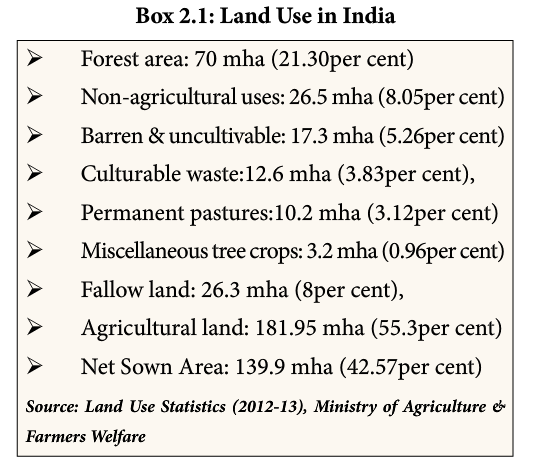Agriculture and the Indian Economy:
Agriculture plays a vital role in India’s economy. 54.6% of the population is engaged in agriculture and allied activities (census 2011) and it contributes 17.4% to the country’s Gross Value Added. Besides, agriculture is an important source of raw material for industrial production and serves as a huge market for industrial products.
“It is in the agriculture sector that the battle for long term economic development will be won or lost.”- Gunnar Myrdal
Before we study this important sector, let’s look at some basic terms and statistics:
Some Important Terms and Statistics:
- Total Geographical Area of India:
As per the land use statistics 2012-13, the total geographical area of the country is 328.7 million hectares. The latest figures of geographical area of the State/Union Territories are as provided by the Office of the Surveyor General of India.
- Total Reporting Area for Land Utilisation Statistics:
The Reporting area stands for the area for which data on land use classification are available. As per the land use statistics 2012-13, the total reporting area is 305.9 million hectares. [Difference between the total geographical area and reporting area is on account of mapping issues due to difficult terrain + disputed land between India-Pak & India- China]
- Net Sown Area:
This represents the total area sown with crops and orchards. The area sown more than once in the same year is counted only once.
Net Sown Area in India: 139.9 million hectares (42.57% of the total geographical area)
- Gross Cropped Area
This represents the total area sown once and/or more than once in a particular year, i.e. the area is counted as many times as there are sowings in a year. This total area is also known as total cropped area or total area sown.
Gross Cropped Area in India: 194.4 million hectares (59.14% of the total geographical area)
- Cropping Intensity
It is the ratio of the Total Cropped Area (or the gross cropped area) to the Net Area Sown.
Cropping Intensity in India = (Gross Cropped Area ÷Net Area Sown) * 100
= (194.4 ÷ 139.9) * 100
= 138.9%.
Therefore, more the use of arable land during a year more is the cropping intensity. Cropping Intensity depends on a number of factors:
- Natural factors – More in areas with high temperatures and rainfall, cultivation is not possible in areas of cold climates/frost etc.
- Socio-economic factors – Often the lands near towns have more cropping intensity because of higher demand of fruits, vegetables, flowers etc in urban areas.
- Institutional Factors – Availability of irrigation facilities, good quality seeds, fertilizers etc also impacts the cropping intensity of a region. Eg. Higher cropping intensity in Punjab because of better infrastructural and institutional facilities.
- Fallow land
Fallow land includes the land out of cultivation for one to five years.
- Culturable Waste:
It includes the areas which can be brought under cultivation by efforts.
Determinants of Agriculture
The following factors determine the cropping pattern, yield of crops and overall agricultural development:
- Physical factors – Topography, Climate and Soil
- Institutional factors – Land holding size, land tenure
- Infrastructural factors – Irrigation, Electricity, Credit, Roads, Storage, Marketing
- Technological factors – High Yielding Variety (HYV) seeds, fertilisers, insecticides, pesticides, farm machinery.
Types of Farming:
Agriculture is an age-old economic activity in our country. Over the years, cultivation methods have changed quite significantly depending on the above-mentioned factors. Farming varies from subsistence to commercial type.
Following are the 8 major farming systems practised in India:
Subsistence Farming
- Shifting Agriculture
- Plantation Agriculture
- Intensive Farming
- Dry Agriculture
- Mixed and Multiple Agriculture
- Crop-Rotation
- Terrace Cultivation
To read about these farming systems in detail, click here!
Cropping Seasons in India:
India has the following three cropping seasons:
1. Rabi:
- Rabi crops are sown in winter (from October to December) and harvested in summer (from April to June).
- Major rabi crops are wheat, barley, gram, peas, mustard etc.
- Though these crops are grown in large parts of India, states from the north and north-western parts such as Punjab, Haryana, Uttar Pradesh, Himachal Pradesh, Haryana, Jammu and Kashmir are important for the production of wheat and other rabi crops. This can be attributed to:
- The availability of precipitation in the winter months due to the western temperate cyclones.
- The success of green revolution in these areas.
2. Kharif:
- Kharif crops are sown with the onset of monsoon in different parts of the country and are harvested in September to October.
- The major Kharif crops are rice, jowar, bajra, maize, jute, groundnut, cotton, arhar, moong, urad, soyabean etc.
3. Zaid:
- In between the rabi and Kharif seasons, there is a short season during the summer months known as the Zaid season.
- Vegetables, watermelon, musk melon, cucumber, fodder crops etc. which are grown with the help of irrigation fall under this category.
Important Crops:
Variations in the physical environment and preferences for various types of food in India have resulted in a large number of crops being grown. In the next article, we will look at the chief crops grown in India, the geographical conditions required for their growth and their important producing areas.
Note4students:
Pay special attention to the geographical conditions required for the growth of each crop (i.e. soils, temperature conditions, rainfall requirements etc). Correlate these with the climatic regions and soil distribution in India (as discussed in the previous articles). It would help in memorization of the important producing areas and other details.



Thanks for the notes.
One question to all the readers, which state in India is the largest producer of coal as of 2019/2020?
In some website I find the answer as jarkhand and in another website I also find chhatisgarh as the answer. Please help. Thank you.
Its Jharkhand .
Kindly refer – https://coal.nic.in/content/coal-reserves
Thank you.